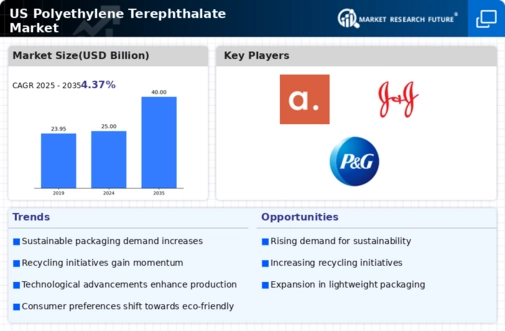The polyethylene terephthalate market exhibits a dynamic competitive landscape characterized by robust growth drivers such as increasing demand for sustainable packaging solutions and advancements in recycling technologies. Key players like Indorama Ventures (TH), Eastman Chemical Company (US), and SABIC (SA) are strategically positioned to leverage these trends. Indorama Ventures (TH) focuses on expanding its recycling capabilities, aiming to enhance its sustainability profile, while Eastman Chemical Company (US) emphasizes innovation in product development, particularly in high-performance materials. SABIC (SA) is actively pursuing partnerships to bolster its supply chain resilience, thereby shaping a competitive environment that prioritizes sustainability and technological advancement.
The market structure appears moderately fragmented, with several players vying for market share through localized manufacturing and supply chain optimization. Companies are increasingly localizing their production to reduce logistics costs and enhance responsiveness to regional demand fluctuations. This strategy not only strengthens their market presence but also fosters a competitive atmosphere where agility and efficiency are paramount.
In October 2025, Indorama Ventures (TH) announced the launch of a new recycling facility in the US, aimed at increasing its production capacity for recycled PET. This strategic move is significant as it aligns with the growing consumer preference for sustainable products and positions the company as a leader in the circular economy. The facility is expected to enhance Indorama's ability to meet the rising demand for recycled materials, thereby reinforcing its competitive edge.
In September 2025, Eastman Chemical Company (US) unveiled a new line of sustainable PET products designed for the food and beverage industry. This initiative reflects the company's commitment to innovation and sustainability, catering to the increasing regulatory pressures and consumer demand for eco-friendly packaging solutions. By diversifying its product offerings, Eastman is likely to capture a larger market share and strengthen its position in the competitive landscape.
In August 2025, SABIC (SA) entered into a strategic partnership with a leading technology firm to develop advanced recycling technologies for PET. This collaboration is poised to enhance SABIC's capabilities in producing high-quality recycled materials, which is crucial in meeting the stringent sustainability targets set by various stakeholders. The partnership underscores the importance of technological innovation in maintaining a competitive advantage in the market.
As of November 2025, the competitive trends in the polyethylene terephthalate market are increasingly defined by digitalization, sustainability initiatives, and the integration of AI technologies. Strategic alliances are becoming more prevalent, enabling companies to pool resources and expertise to address complex challenges. The shift from price-based competition to a focus on innovation, technology, and supply chain reliability is evident, suggesting that future competitive differentiation will hinge on the ability to adapt to evolving market demands and sustainability imperatives.














Leave a Comment